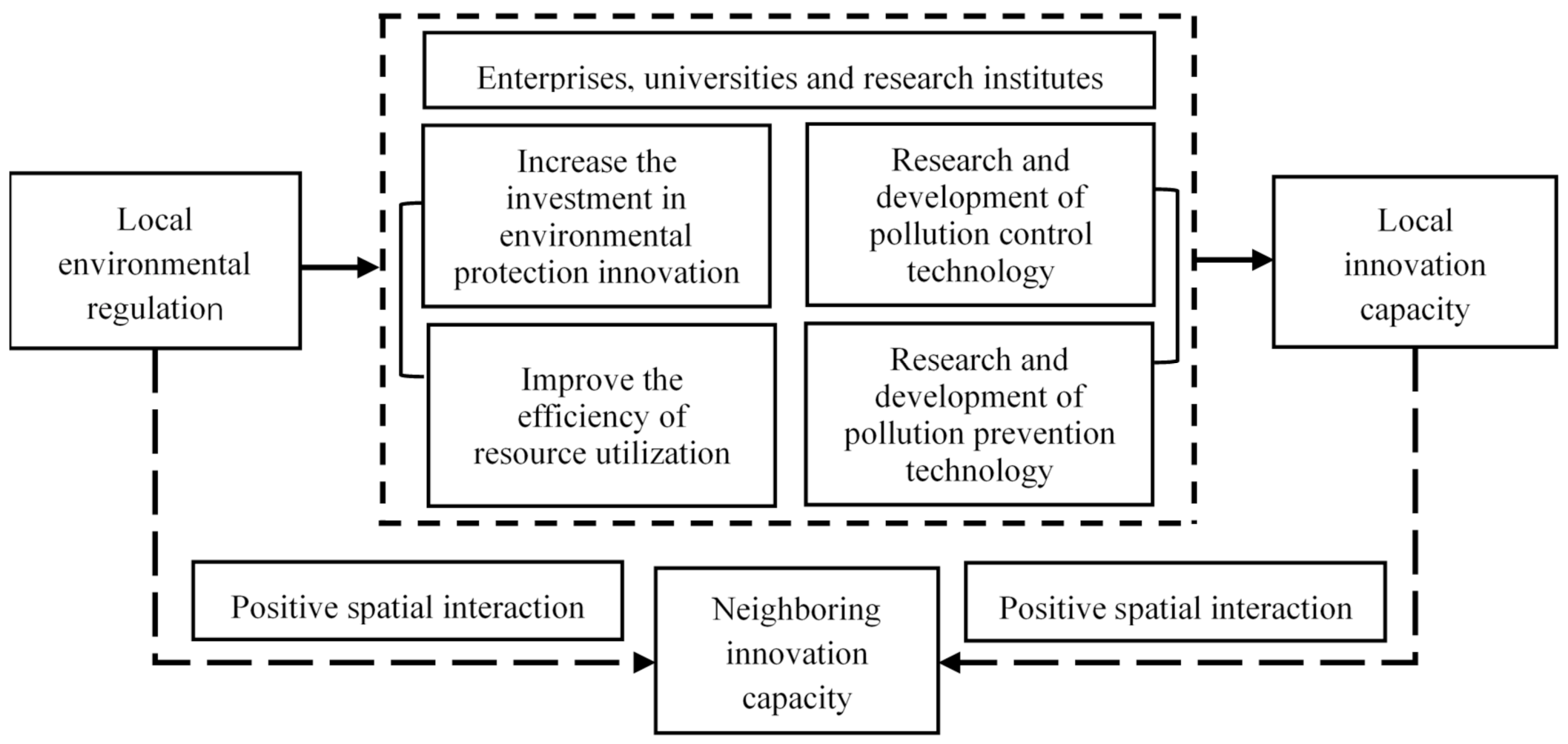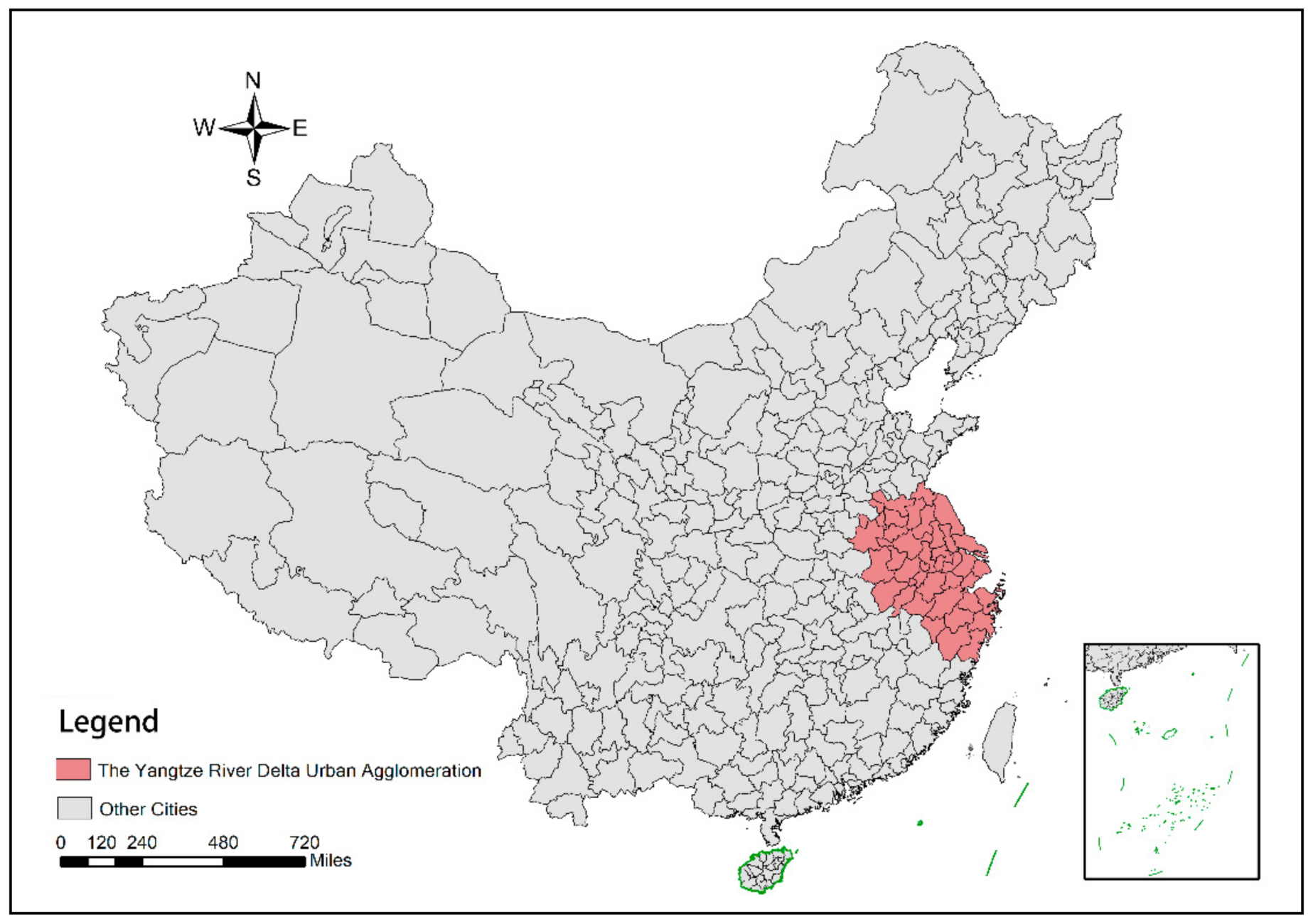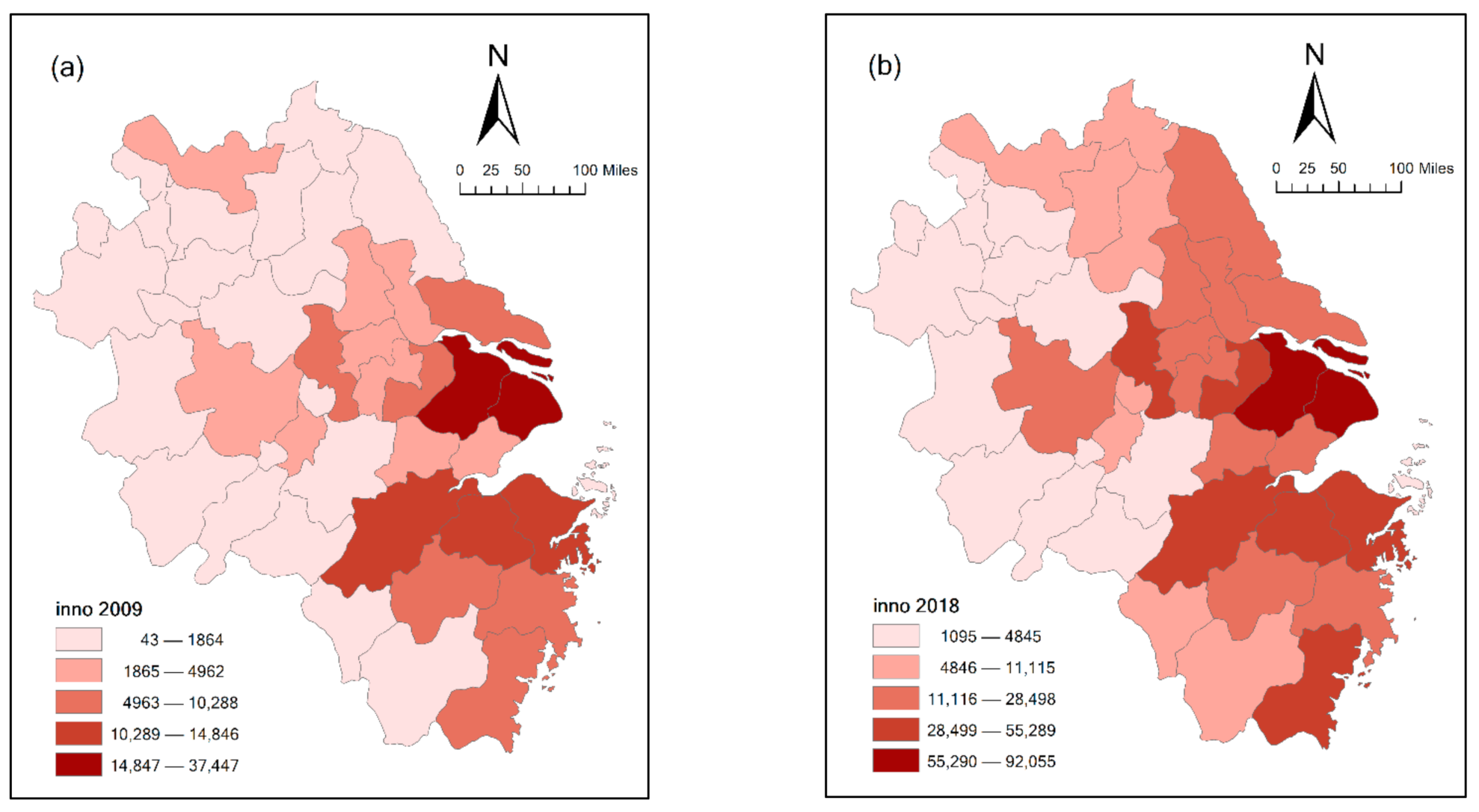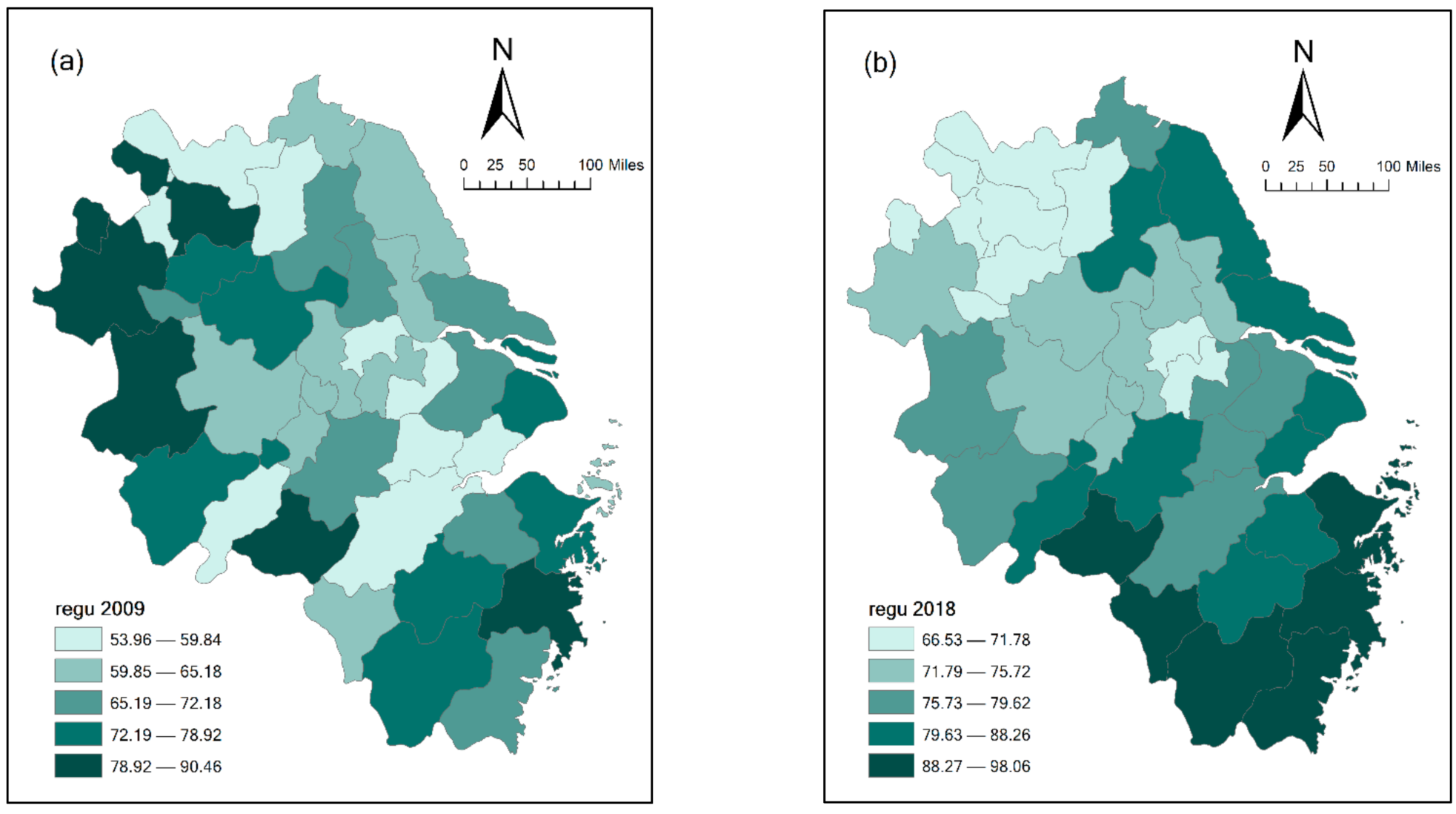The Spatial Interaction Effect of Environmental Regulation on Urban Innovation Capacity: Empirical Evidence from China
Abstract
:1. Introduction
2. Research Hypotheses
3. Materials and Methods
3.1. Study Area
3.2. Variable Selection
3.2.1. Explained Variable
3.2.2. Explanatory Variable
- 1.
- Normalize the positive indicators, the normalized indicator is:
- 2.
- Calculate the proportion of indicator j from region i in year t:
- 3.
- Calculate the information entropy of variable j:
- 4.
- Calculate the j variable weight :
- 5.
- Calculate the environmental regulation score of city i in year t:
3.2.3. Control Variables
- The level of urban informatization (). The informatization level of a city can reflect the ability to exchange and share information of a city. Furthermore, the construction of information exchange platforms and the efficiency of information exchange can ensure that a city introduces innovative resources for re-innovation. This paper used the number of Internet broadband access users to express the informatization level of a city [39].
- The level of urban science and technology investment (). Investment in science and technology can provide financial support for urban innovation activities and reduce the risk of innovation activities due to a long R&D cycle and uncertain R&D results. This paper used the expenditure for science and technology within the general public budget expenditure to express the level of urban science and technology investment [40].
- City size (). The size of a city will affect the employment choice of innovative personnel, the location of innovative enterprises and the interaction among innovation entities [23]. We use the urban registered population to represent the city size.
- The level of urban economic development (). The economic level of a city reflects the economic growth rate and growth potential of a city. The economic scale will affect the aggregation of innovative talents and enterprises [41]. This paper used GDP to measure the urban economic development level.
- The level of urban industrial development (). Industrial enterprises constantly carry out technological innovation and invention in the process of daily production and upgrading [41]. In 2015, after the “Industry 4.0” strategic cooperation between China and Germany, to build intelligent industry, industrial companies further became one of the main innovation bodies of cities. Therefore, the number of units of industrial enterprises above a designated size was chosen to represent the level of industrial development.
- The education level of the urban population (). As the incubators of innovation, colleges and universities provide a favorable environment for urban innovation and cultivate potential innovative talents [38]. Therefore, this paper selected the number of students enrolled in regular institutions of higher education to represent the education level of the urban population.
3.3. Spatial Econometric Model
3.3.1. Spatial Autocorrelation Test
3.3.2. Model Selection and Design
3.4. Data Sources
4. Results and Discussion
4.1. Descriptive Statistical Analysis of Variables
4.2. Spatial Characteristics of the Main Variables
4.3. Discussion of SAR Regression Results
4.4. Discussion of Spatial Effect of SAR
4.5. Robustness Test
5. Conclusions
Author Contributions
Funding
Institutional Review Board Statement
Informed Consent Statement
Data Availability Statement
Conflicts of Interest
References
- Li, R. Theoretical analysis of the relationship among environmental regulation, performance innovation and performance. In Research on the Relationship between Environmental Regulation, Technological Innovation and Performance—The Integrity Test of Porter Hypothesis in China’s Industry; Heilongjiang University Press: Harbin, China, 2019; pp. 34–62. ISBN 978-7-5686-0397-3. [Google Scholar]
- Zhang, J.; Zhou, M. A Review of Changes in Chinese Environmental Regulation System. Adv. Mat. Res. 2014, 955–959, 1681–1684. [Google Scholar] [CrossRef]
- Zhang, B.; Cao, C.; Gu, J.; Liu, T. A new environmental protection law, many old problems? Challenges to environmental governance in China. J. Environ. Law 2016, 28, 325–335. [Google Scholar] [CrossRef]
- National People’s Congress of the P.R. China. Environmental Protection Law of the People’s Republic of China. Available online: http://language.chinadaily.com.cn/trans/2014-05/20/content_17522868_4.htm (accessed on 10 April 2021).
- Zhang, L.; He, G.; Mol, A.P.J. China’s new environmental protection law: A game changer? Environ. Dev. 2015, 13, 1–3. [Google Scholar] [CrossRef] [Green Version]
- Cordeiro, J.J.; Sarkis, J. Environmental proactivism and firm performance: Evidence from security analyst earnings forecasts. Bus. Strategy Environ. 1997, 6, 104–114. [Google Scholar] [CrossRef]
- Lin, C.; Gong, X.; Kong, F. Environmental Regulation and Green Technology Advancement: Promotion or Suppression—Based on the Perspective of Spatial Effects. Macro 2019, 11, 131–142. [Google Scholar] [CrossRef]
- Guo, J.; Zhang, Z. Diversity Research About Environmental Regulation Intensity Influence on Technology Innovation—Based on the Analysis on Provincial Panel Data from 2003 to 2012. J. Ind. Tech. Econ. 2015, 34, 85–90. [Google Scholar] [CrossRef]
- Zhong, S.; Xiong, Y.; Xiang, G. Environmental regulation benefits for whom? Heterogeneous effects of the intensity of the environmental regulation on employment in China. J. Environ. Manag. 2021, 281, 111877. [Google Scholar] [CrossRef]
- Sun, Z.; Wang, X.; Liang, C.; Cao, F.; Wang, L. The impact of heterogeneous environmental regulation on innovation of high-tech enterprises in china: Mediating and interaction effect. Environ. Sci. Pollut. Res. 2021, 28, 8323–8336. [Google Scholar] [CrossRef]
- Song, Y.; Yang, T.; Zhang, M. Research on the impact of environmental regulation on enterprise technology innovation—An empirical analysis based on Chinese provincial panel data. Environ. Sci. Pollut. Res. 2019, 26, 21835–21848. [Google Scholar] [CrossRef]
- Chen, Y.; Li, L.; Fu, T. Spatial Heterogeneity in Chinese Urban Innovation Capacities and Its Determinants: Approach Based on the Geographically Weighted Regression Model. Trop. Geogr. 2020, 40, 323–334. [Google Scholar] [CrossRef]
- Luo, Y.; Salman, M.; Lu, Z. Heterogeneous impacts of environmental regulation and foreign direct investment on green innovation across different regions in China. Sci. Total Environ. 2021, 759, 143744. [Google Scholar] [CrossRef]
- Wang, S. Evolution Track and Expectation of National Independent Innovation Demonstration Zone. Reform 2017, 279, 82–94. Available online: http://www.cnki.com.cn/Article/CJFDTotal-REFO201705006.htm (accessed on 20 February 2021).
- Gu, J.; Peng, J. Study on the System and Mechanism Innovation of National Independent Innovation Demonstration Zone under the Background of High-Quality Development. Acad. J. Zhongzhou 2020, 286, 26–31. Available online: http://www.cnki.com.cn/Article/CJFDTotal-ZZXK202010006.htm (accessed on 20 February 2021).
- National Development and Reform Commission. The Overall Plan of the Demonstration Zone of Green and Integrated Ecological Development of the Yangtze River Delta. Available online: https://www.ndrc.gov.cn/xwdt/ztzl/cjsjyth1/ghzc/202007/P020200728576152165824.pdf (accessed on 18 February 2021).
- The Central Committee of the Communist Party of China. Outline of the Integrated Regional Development of the Yangtze River Delta. Available online: http://www.gov.cn/zhengce/2019-12/01/content_5457442.htm (accessed on 18 February 2021).
- Porter, M.E.; Linde, C.V.D. Towards a New Conception of the Environment-Competitiveness Relationship. J. Econ. Perspect. 1995, 9, 97–118. [Google Scholar] [CrossRef]
- Zhou, H.; Qu, S.; Wu, Z.; Ji, Y. A study of environmental regulation, technological innovation, and energy consumption in China based on spatial econometric models and panel threshold models. Environ. Sci. Pollut. Res. 2020, 27, 37894–37910. [Google Scholar] [CrossRef]
- Yang, Y.; Wang, Y. Research on the Impact of Environmental regulation on the Green Innovation Efficiency of Chinese Industrial Enterprises. Pol. J. Environ. Stud. 2020, 30, 15244. [Google Scholar]
- Zhang, H.; Zhu, Z.; Fan, Y. The impact of environmental regulation on the coordinated development of environment and economy in China. Nat. Hazards 2018, 91, 473–489. [Google Scholar] [CrossRef]
- Liu, L.; Zhao, Z.; Zhang, M.; Zhou, C.; Zhou, D. The effects of environmental regulation on outward foreign direct investment’s reverse green technology spillover: Crowding out or facilitation? J. Clean. Prod. 2020, 284, 124689. [Google Scholar] [CrossRef]
- Zhou, Q.; Song, Y.; Wan, N.; Zhang, X. Non-linear effects of environmental regulation and innovation—Spatial interaction evidence from the Yangtze River Delta in China. Environ. Sci. Policy 2020, 114, 263–274. [Google Scholar] [CrossRef]
- He, X.; Chen, S. Does environmental regulation promote or inhibit technological innovation—Based on the perspective of spatial spillover effect. J. Fin. Econ. 2020, 1, 50–57. [Google Scholar] [CrossRef]
- Romer, P.M. Endogenous Technological Change. J. Polit. Econ. 1990, 98, 71–102. Available online: http://www.jstor.org/stable/2937632 (accessed on 20 February 2021). [CrossRef] [Green Version]
- Si, L. The impact of environmental regulation on green technology innovation—An empirical analysis based on panel data of the Yellow River Basin. Res. Fin. Econ. Issues 2020, 440, 41–49. [Google Scholar] [CrossRef]
- Han, J.; Kong, L. Research on the Interaction between the Flow of Innovation Factors and the Change of Industrial Structure and the Effect of Spatial Spillover. Sci. Tech. Prog. Policy 2020, 37, 59–67. [Google Scholar] [CrossRef]
- Li, W.; Gu, Y.; Liu, F.; Li, C. The effect of command-and-control regulation on environmental technological innovation in China: A spatial econometric approach. Environ. Sci. Pollut. Res. 2019, 26, 34789–34800. [Google Scholar] [CrossRef]
- Zhou, R.; Liu, G.; Zhang, Y. Sustainability evaluation and spatial heterogeneity of urban agglomerations: A China case study. Discov. Sustain. 2021, 2, 1. [Google Scholar] [CrossRef]
- National Bureau of Statistics. China Statistical Yearbook. 2020. Available online: https://data.cnki.net/yearbook/Single/N2020100004 (accessed on 18 February 2021).
- Prajogo, D.I.; Ahmed, P.K. Relationships between innovation stimulus, innovation capacity, and innovation performance. R&D Manag. 2006, 36, 499–515. [Google Scholar] [CrossRef]
- López-Claros, A.; Mata, Y.N. Policies and Institutions Underpinning Country Innovation: Results from the Innovation Capacity Index. In The Innovation for Development Report 2010–2011; López-Claros, A., Ed.; Palgrave Macmillan: London, UK, 2011; pp. 3–63. ISBN 978-0-230-29926-9. [Google Scholar]
- Fan, P. Innavation capacity and economic development: China and India. Econ. Chang. Restruct. 2011, 44, 49–73. [Google Scholar] [CrossRef]
- Rodríguez-Pose, A.; Lee, N. Hipsters vs. geeks? Creative workers, STEM and innovation in US cities. Cities 2020, 100, 101653. [Google Scholar] [CrossRef] [Green Version]
- de la Potterie, B.V.P.; de Rassenfosse, G. Policymakers and the R&D-patent relationship. Inter. Econ. 2008, 43, 377–380. [Google Scholar] [CrossRef] [Green Version]
- Xie, R.H.; Yuan, Y.J.; Huang, J.J. Different Types of Environmental Regulations and Heterogeneous Influence on “Green” Productivity: Evidence from China. Ecol. Econ. 2017, 132, 104–112. [Google Scholar] [CrossRef]
- Shen, N.; Liao, H.; Deng, R.; Wang, Q. Different types of environmental regulations and the heterogeneous influence on the environmental total factor productivity: Empirical analysis of China’s industry. J. Clean. Prod. 2019, 211, 171–184. [Google Scholar] [CrossRef]
- Fan, F.; Lian, H.; Liu, X.; Wang, X. Can environmental regulation promote urban green innovation efficiency? An empirical study based on Chinese cities. J. Clean. Prod. 2021, 287, 125060. [Google Scholar] [CrossRef]
- Shangguan, X.; Ge, B. Scientific and technological innovation, environmental regulation and high-quality economic development: Empirical evidence from 278 Chinese cities at prefecture level and above. China Pop. Resour. Environ. 2020, 30, 95–104. Available online: http://www.cnki.com.cn/Article/CJFDTotal-ZGRZ202006010.htm (accessed on 20 February 2021).
- Liu, Z.; Yang, L.; Fan, L. Induced Effect of Environmental Regulation on Green Innovation: Evidence from the Increasing-Block Pricing Scheme. Int. J. Environ. Res. Public Health 2021, 18, 2620. [Google Scholar] [CrossRef]
- Li, J.; Du, Y. Spatial effect of environmental regulation on green innovation efficiency: Evidence from prefectural-level cities in China. J. Clean. Prod. 2021, 286, 125032. [Google Scholar] [CrossRef]
- Wooldridge, J.M. Control Function Methods in Applied Econometrics. J. Hum. Resour. 2015, 50, 420–445. [Google Scholar] [CrossRef]
- Anselin, L.; Le Gallo, J.; Jayet, H. Spatial Panel Econometrics. In The Econometrics of Panel Data: Advanced Studies in Theoretical and Applied Econometrics; Mátyás, L., Sevestre, P., Eds.; Springer: Berlin/Heidelberg, Germany, 2008; pp. 625–660. ISBN 978-3-540-75892-1. [Google Scholar]
- Elhorst, J.P. Spatial Panel Data Models. In Spatial Econometrics: From Cross-Sectional Data to Spatial Panels; China Renmin University Press: Beijing, China, 2015; pp. 49–112. ISBN 978-7-300-21024-7. [Google Scholar]
- LeSage, J.; Pace, R.K. Maximum Likelihood Estimation. In Introduction to Spatial Econometrics; Peking University Press: Beijing, China, 2014; pp. 33–55. ISBN 978-7-301-23322-1. [Google Scholar]
- National Bureau of Statistics of China. China Statistical Yearbook. 2019. Available online: https://data.cnki.net/Yearbook/Single/N2019110002 (accessed on 20 February 2021).
- National Bureau of Statistics of China. China City Statistical Yearbook. 2019. Available online: https://db.cei.cn/ (accessed on 20 February 2021).
- Ministry of Housing and Urban-Rural Development of the P.R China. China Urban Construction Statistical Yearbook; 2019. Available online: https://data.cnki.net/yearbook/Single/N2020050213 (accessed on 20 February 2021).
- National Bureau of Statistics of China; Ministry of Environmental Protection of the P.R China. China Statistical Yearbook on Environment 2019. Available online: https://d.qianzhan.com/ (accessed on 8 February 2021).
- Investigation Team of Bureau of Statistics. The Statistical Bulletin on National Economic and Social Development. 2018. Available online: https://data.cnki.net/yearbook/Single/N2019080022 (accessed on 18 February 2021).
- Yi, M.; Wang, Y.; Yan, M.; Fu, L.; Zhang, Y. Government R&D Subsidies, Environmental regulation, and Their Effect on Green Innovation Efficiency of Manufacturing Industry: Evidence from the Yangtze River Economic Belt of China. Int. J. Environ. Res. Public Health 2020, 17, 1330. [Google Scholar] [CrossRef] [Green Version]
- Deng, J.; Zhang, N.; Ahmad, F.; Draz, M.U. Local Government Competition, Environmental Regulation Intensity and Regional Innovation Performance: An Empirical Investigation of Chinese Provinces. Int. J. Environ. Res. Public Health 2019, 16, 2130. [Google Scholar] [CrossRef] [Green Version]
- Quah, D. The Global Economy’s Shifting Centre of Gravity. Glob. Policy 2011, 2, 3–9. [Google Scholar] [CrossRef]
- Zhai, J.; Zhang, J. City Size, Innovation Ability and Spatial Spillover Effect: A Case Study of Urban Agglomerations in the Yangtze River Delta of China. Contemp. Econ. Manag. 2020, 42, 30–37. [Google Scholar] [CrossRef]




| Year | ||
|---|---|---|
| 2009 | 0.5292 *** (4.6427) | 0.0116 (0.1128) |
| 2010 | 0.5371 ***(4.7076) | 0.0191 (0.3712) |
| 2011 | 0.4592 *** (4.0607) | 0.0942 (1.0009) |
| 2012 | 0.4447 *** (3.9482) | 0.2351 ** (2.1874) |
| 2013 | 0.4568 *** (4.0492) | 0.3344 *** (3.0060) |
| 2014 | 0.4844 *** (4.2695) | 0.1688 * (1.6500) |
| 2015 | 0.5175 *** (4.5433) | 0.4527 *** (4.0232) |
| 2016 | 0.4729 *** (4.1721) | 0.5594 *** (4.9449) |
| 2017 | 0.4653 *** (4.1096) | 0.6150 *** (5.4108) |
| 2018 | 0.4731 *** (4.1748) | 0.6143 *** (5.3794) |
| Null Hypothesis | Statistic | p-Value |
|---|---|---|
| LM test no spatial | 148.6278 | 0.0000 |
| robust LM test no spatial lag | 28.3518 | 0.0000 |
| LM test no spatial error | 122.0444 | 0.0000 |
| robust LM test no spatial error | 1.7684 | 0.1840 |
| Statistic | Degrees of Freedom | p-Value |
|---|---|---|
| 29.9527 | 8 | 0.0002 |
| Test Statistic | Statistic | Freedom | p-Value |
|---|---|---|---|
| LR-test joint significance spatial fixed effects | 389.0234 | 41 | 0.0000 |
| LR-test joint significance time-period fixed effects | 153.3537 | 10 | 0.0000 |
| Variables | Mean | Std. Dev. | Min | Max | Obs | Unit |
|---|---|---|---|---|---|---|
| inno | 11,922.66 | 15,762.83 | 43.00 | 92,055.00 | 410 | piece |
| regu | 75.99 | 9.33 | 53.96 | 98.06 | 410 | % |
| info | 119.25 | 123.98 | 7.00 | 773.00 | 410 | 104 households |
| exp | 163,820.93 | 463,029.80 | 1100.00 | 4,263,655.00 | 410 | 104 yuan |
| size | 202.81 | 222.06 | 29.00 | 1462.00 | 410 | 104 persons |
| ec | 2214.84 | 4040.90 | 112.18 | 32,679.87 | 410 | 108 yuan |
| ent | 1385.75 | 1992.07 | 119.00 | 17,611.00 | 410 | unit |
| edu | 105,628.02 | 158,315.00 | 4100.00 | 859,555.00 | 410 | person |
| Variables | Estimated Value | z-Value | p-Value |
|---|---|---|---|
| Wlninno | 0.3850 *** | 7.4212 | 0.0000 |
| regu | 1.0319 *** | 5.2115 | 0.0000 |
| info | 0.3954 *** | 3.7453 | 0.0002 |
| exp | 0.0910 ** | 2.0923 | 0.0364 |
| size | −0.9753 *** | −5.3036 | 0.0000 |
| ec | 0.6094 *** | 3.4905 | 0.0005 |
| ent | 0.3683 *** | 3.6455 | 0.0003 |
| edu | −0.0680 | −0.5840 | 0.5592 |
| Variables | Direct Effect | Indirect Effect | Total Effect |
|---|---|---|---|
| regu | 1.0677 *** (5.2420) | 0.6076 *** (3.5788) | 1.6753 *** (4.8624) |
| info | 0.4119 *** (3.7483) | 0.2330 *** (3.0888) | 0.6450 *** (3.6774) |
| exp | 0.0952 ** (2.1072) | 0.0541 * (1.8799) | 0.1494 ** (2.0631) |
| size | −1.0113 *** (−5.4148) | −0.5762 *** (−3.5606) | −1.5875 *** (−4.9377) |
| ec | 0.6310 *** (3.4537) | 0.3609 *** (2.6873) | 0.9919 *** (3.2661) |
| ent | 0.3845 *** (3.8341) | 0.2182 *** (3.0646) | 0.6027 *** (3.7173) |
| edu | −0.0743 (−0.6055) | −0.0428 (−0.5979) | −0.1171 (−0.6066) |
| Variables | Direct Effect | Indirect Effect | Total Effect |
|---|---|---|---|
| regu | 0.0176 (0.7855) | 0.0102 (0.7566) | 0.0278 (0.7803) |
| info | 0.4585 *** (4.2142) | 0.2664 *** (3.4425) | 0.7249 *** (4.1840) |
| exp | 0.0963 ** (2.1606) | 0.0563 * (1.9169) | 0.1526 ** (2.1065) |
| size | −0.7789 *** (−4.1425) | −0.4575 *** (−3.0444) | −1.2364 *** (−3.8730) |
| ec | 0.6863 *** (3.6500) | 0.4039 *** (2.7754) | 1.0901 *** (3.4291) |
| ent | 0.1341 (1.6016) | 0.0783 (1.5064) | 0.2124 (1.5894) |
| edu | −0.1030 (−0.8003) | −0.0606 (−0.7818) | −0.1636 (−0.7996) |
| Year | 2009–2013 | 2014–2018 | ||||
|---|---|---|---|---|---|---|
| Variable | Direct Effect | Indirect Effect | Total Effect | Direct Effect | Indirect Effect | Total Effect |
| regu | 1.6247 *** (4.4674) | 0.6445 ** (2.2812) | 2.2691 *** (3.9570) | 0.5120 ** (2.5980) | 0.3839 ** (2.1011) | 0.8958 ** (2.4881) |
| info | 0.7440 *** (4.2270) | 0.2930 ** (2.3064) | 1.0370 *** (3.8732) | 0.0772 (0.8417) | 0.0569 (0.7932) | 0.1340 (0.8321) |
| exp | 0.2511 ** (2.5467) | 0.0986 * (1.8396) | 0.3497 ** (2.4616) | 0.1094 ** (2.6649) | 0.0830 ** (2.0734) | 0.1924 ** (2.4993) |
| size | −0.7785 ** (−2.4660) | −0.3033 * (−1.8887) | −1.0818 ** (−2.4274) | −0.6285 ** (−2.3180) | −0.4730 ** (−1.9162) | −1.1015 ** (−2.2240) |
| ec | 0.5842 ** (2.1505) | 0.2318 (1.6153) | 0.8160 ** (2.0750) | 0.3492 (1.5684) | 0.2536 (1.4947) | 0.6028 (1.5789) |
| ent | 0.1436 (0.8869) | 0.0538 (0.7840) | 0.1975 (0.8722) | 0.2707 * (1.8502) | 0.2062 (1.5608) | 0.4769 * (1.7660) |
| edu | 0.0672 (0.2908) | 0.0241 (0.2442) | 0.0912 (0.2801) | 0.0395 (0.3343) | 0.0316 (0.3408) | 0.0711 (0.3403) |
Publisher’s Note: MDPI stays neutral with regard to jurisdictional claims in published maps and institutional affiliations. |
© 2021 by the authors. Licensee MDPI, Basel, Switzerland. This article is an open access article distributed under the terms and conditions of the Creative Commons Attribution (CC BY) license (https://creativecommons.org/licenses/by/4.0/).
Share and Cite
Zhou, R.; Zhang, Y.; Gao, X. The Spatial Interaction Effect of Environmental Regulation on Urban Innovation Capacity: Empirical Evidence from China. Int. J. Environ. Res. Public Health 2021, 18, 4470. https://doi.org/10.3390/ijerph18094470
Zhou R, Zhang Y, Gao X. The Spatial Interaction Effect of Environmental Regulation on Urban Innovation Capacity: Empirical Evidence from China. International Journal of Environmental Research and Public Health. 2021; 18(9):4470. https://doi.org/10.3390/ijerph18094470
Chicago/Turabian StyleZhou, Ruomeng, Yunsheng Zhang, and Xincai Gao. 2021. "The Spatial Interaction Effect of Environmental Regulation on Urban Innovation Capacity: Empirical Evidence from China" International Journal of Environmental Research and Public Health 18, no. 9: 4470. https://doi.org/10.3390/ijerph18094470
APA StyleZhou, R., Zhang, Y., & Gao, X. (2021). The Spatial Interaction Effect of Environmental Regulation on Urban Innovation Capacity: Empirical Evidence from China. International Journal of Environmental Research and Public Health, 18(9), 4470. https://doi.org/10.3390/ijerph18094470







